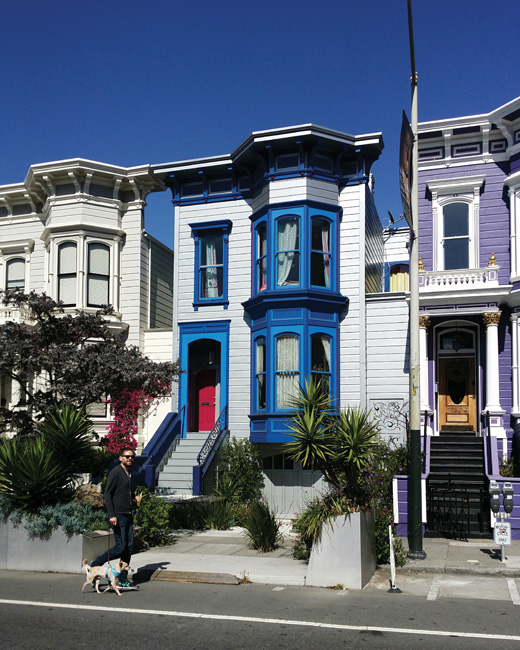Humans have evolved to scan their surroundings to scout for threats and opportunities. In the modern city, a speeding bus rather than a sprinting animal, may pose the threat while an inviting fruit stand may present the opportunity. And while we have cleverly devised ways to build upward, humans did not fundamentally evolve to look upward. Despite the detailed aerial imagery so common in architecture and urban design, we do not see, interact with, or experience spaces from a bird’s eye perspective. We commute, commune, eat, shop, share, and play amidst buildings and at ground level. Doing so, we are immersed in the first 20 feet of the vertical space around us. So why aren’t we designing it better?
This streetscape — this urban savannah — is our ecosystem, where we interact with our city environment, its cycles and its flow.
We have all shopped at a street-side store and sat at a sidewalk café, and these uses, done well, are absolutely the fundamentals of active edges. But the key to the vigor of any ecosystem is diversity.
It is time to expand and diversify the idea of active use. To expand the notion of mixed use to perhaps one of mixed-up use: The more mixed up, the more dynamic with retail, residential, common space, open space, micro space, maker space, and light industrial not only existing side by side, but within the very same places.
Retail and Beyond

A lively sidewalk in Chinatown functions as a market, thoroughfare and bus stop as inside spills outside of micro-to-moderately sized shops.
Image by David Baker Architects

This 14-foot high ground level is just enough to keep this retail space contextual, airy, and human-scaled. Ceiling heights are better higher - a minimum of 12-foot or 15-foot is good — and 20-foot is great.
Richardson Apartments, David Baker Architects
Photo by Matthew Millman

This unexpected 7-foot wide pop-up shop engages the street with a transparent bay overhead. It both defines and engages the adjacent public plaza.
Aether Apparel at PROXY, envelope A+D
Image courtesy of envelope A + D

SHED rethinks retail with a vibrant mix of uses — a market, café, mercantile store and meeting space — that are connected to the street through large garage doors that open onto a public plaza.
SHED, Jensen Architects
Photo by Mariko Reed
Live to Work

Residential stoops place ever-important “eyes on the street” and make up a critical mass of San Francisco’s public street edges.
Photo by David Baker Architects

A thoughtful planted buffer – patio, porch or stoop – enables the co-existence of public and private uses next to each other.
Pacific Cannery Lofts David Baker Architects
Photo by Brian Rose

20-feet at the ground floor provides maximum flexibility and the option to have a second level. These live/work lofts house a variety of tenants and uses including residential dwellings, offices and a hair salon.
Emeryville Lofts, David Baker Architects
Photo by Brian Rose

Work can happen outside the office (and on the street!) with large doors and movable furniture.
Clock Tower Lofts, David Baker Architects
Photo by David Baker Architects

Front Café occupies a repurposed loading dock in a building that houses a diversity of uses — a coffee roastery, a roboticsengineering studio, and a production company. The roll up door sends a message, opens to the street, and shades the sun.
Front Cafe
Photo by David Baker Architects
Cafe to Community

Tables and chairs on the sidewalk are a classic and vital part of San Francisco’s public realm.
Saint Frank Coffee, Open Scope Studio and David Baker Architects
Photo by David Baker Architects

Stable is a community hub hat houses diverse tenants such as a bike messenger service, a cheese school, a florist and an architect. A lively street-side café and outdoor space make possible the crosspollination of the inhabitants from both inside and outside the property line.
Stable, Malcolm Davis Architecture
Photo by Bruce Damonte

H2 Hotel explores the limits of permeability by mixing uses both inside and out. The multi-purpose ground floor space is the hotel lobby, restaurant, and bar.
H2 Hotel, David Baker Architects
Photo by Bruce Damonte

The floor-to-ceiling glass wrapping the SF Jazz Center’s ground-level lobby, café and ensemble room reveals the activity within. The Joe Henderson Lab, the all-glass, acoustically isolated, multipurpose ensemble room (at Linden Alley), puts artists within feet of passersby.
SFJazz, Mark Cavagnero Associates Architects
Photo by TimGriffith

Storefront Lab’s 530 square feet pack a big punch when given over to the community. The Lab’s grant program has hosted a wide range of gatherings from musical performances to furniture making – fueled by diverse people with access to a groundlevel storefront.
Storefront Lab David Baker Architects
Photo by David Baker Architects
